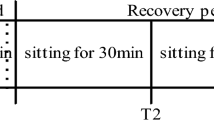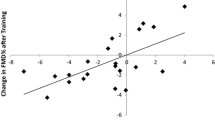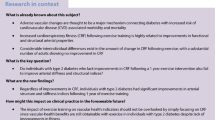Abstract
Purpose
Exercise training in healthy volunteers rapidly improves vascular function, preceding structural remodelling. No study examined the time-course of such adaptations in subjects with a priori endothelial dysfunction.
Methods
We examined brachial artery endothelial and smooth muscle function using flow-mediated dilation (FMD) and glyceryl trinitrate (GTN) administration in 13 type 2 diabetes patients (59 ± 6 years) and 10 healthy subjects (58 ± 7 years) before, during (2-weekly) and after an 8-week training programme. Arterial structure was assessed via peak blood flow and artery diameter.
Results
Training increased peak oxygen uptake (P = 0.03), comparable between groups (P = 0.276). We observed a similar impact of training on brachial artery vasomotor function across the training period in diabetes patients and controls (FMD/GTN-ratio), with a higher FMD/GTN-ratio at 2, 6 and 8 weeks (P = 0.036). Artery diameter, peak blood flow or peak diameter had not changed after training.
Conclusion
Training leads to rapid improvement in brachial artery vascular function in diabetes patients and controls. In contrast to previous observations in healthy young subjects, the increase in function was preserved after 8 weeks of training in middle-aged diabetes patients and controls, suggesting a different time-course in vascular adaptations in subjects with endothelial dysfunction.

Similar content being viewed by others
Abbreviations
- ANOVA:
-
Analysis of variance
- BMI:
-
Body mass index
- bpm:
-
Beats per minute
- eNOS:
-
Endothelial nitric oxide synthase
- FMD:
-
Flow-mediated dilation
- GTN:
-
Glyceryl trinitrate
- HDL:
-
High-density lipoprotein
- HOMA-IR:
-
Homeostasis model assessment for insulin resistance
- HR:
-
Heart rate
- LDL:
-
Low-density lipoprotein
- LSD:
-
Least significant differences
- NO:
-
Nitric oxide
- rpm:
-
Rotations per minute
- RQ:
-
Respiratory quotient
- T2DM:
-
Type 2 diabetes mellitus
- W:
-
Watt
References
Ades PA, Savage PD, Lischke S, Toth MJ, Harvey-Berino J, Bunn JY, Ludlow M, Schneider DJ (2011) The effect of weight loss and exercise training on flow-mediated dilatation in coronary heart disease: a randomized trial. Chest 140(6):1420–1427. doi:10.1378/chest.10-3289
Atkinson G, Batterham AM, Thijssen DH, Green DJ (2013) A new approach to improve the specificity of flow-mediated dilation for indicating endothelial function in cardiovascular research. J Hypertens 31(2):287–291. doi:10.1097/HJH.0b013e32835b8164
Babbitt DM, Diaz KM, Feairheller DL, Sturgeon KM, Perkins AM, Veerabhadrappa P, Williamson ST, Kretzschmar J, Ling C, Lee H, Grimm H, Thakkar SR, Crabbe DL, Kashem MA, Brown MD (2013) Endothelial activation microparticles and inflammation status improve with exercise training in African Americans. Int J Hypertens 2013:538017. doi:10.1155/2013/538017
Barone Gibbs B, Dobrosielski DA, Bonekamp S, Stewart KJ, Clark JM (2012) A randomized trial of exercise for blood pressure reduction in type 2 diabetes: effect on flow-mediated dilation and circulating biomarkers of endothelial function. Atherosclerosis 224(2):446–453. doi:10.1016/j.atherosclerosis.2012.07.035
Birk GK, Dawson EA, Atkinson C, Haynes A, Cable NT, Thijssen DH, Green DJ (2012) Brachial artery adaptation to lower limb exercise training: role of shear stress. J Appl Physiol 112(10):1653–1658. doi:10.1152/japplphysiol.01489.2011
Black MA, Cable NT, Thijssen DH, Green DJ (2008) Importance of measuring the time course of flow-mediated dilatation in humans. Hypertension 51(2):203–210. doi:10.1161/HYPERTENSIONAHA.107.101014
Blair SN, Morris JN (2009) Healthy hearts–and the universal benefits of being physically active: physical activity and health. Ann Epidemiol 19(4):253–256. doi:10.1016/j.annepidem.2009.01.019
Bowles DK, Woodman CR, Laughlin MH (2000) Coronary smooth muscle and endothelial adaptations to exercise training. Exerc Sport Sci Rev 28(2):57–62
Brown MD (2003) Exercise and coronary vascular remodelling in the healthy heart. Exp Physiol 88(5):645–658
Colberg SR, Stansberry KB, McNitt PM, Vinik AI (2002) Chronic exercise is associated with enhanced cutaneous blood flow in type 2 diabetes. J Diabetes Complicat 16(2):139–145
Dunstan DW, Mori TA, Puddey IB, Beilin LJ, Burke V, Morton AR, Stanton KG (1997) The independent and combined effects of aerobic exercise and dietary fish intake on serum lipids and glycemic control in NIDDM. A randomized controlled study. Diabetes Care 20(6):913–921
Ginsberg HN, MacCallum PR (2009) The obesity, metabolic syndrome, and type 2 diabetes mellitus pandemic: Part I. Increased cardiovascular disease risk and the importance of atherogenic dyslipidemia in persons with the metabolic syndrome and type 2 diabetes mellitus. J Cardiometab Syndr 4(2):113–119. doi:10.1111/j.1559-4572.2008.00044.x
Green DJ (2009) Exercise training as vascular medicine: direct impacts on the vasculature in humans. Exerc Sport Sci Rev 37(4):196–202. doi:10.1097/JES.0b013e3181b7b6e3
Green DJ, Walsh JH, Maiorana A, Best MJ, Taylor RR, O’Driscoll JG (2003) Exercise-induced improvement in endothelial dysfunction is not mediated by changes in CV risk factors: pooled analysis of diverse patient populations. Am J Physiol Heart Circ Physiol 285(6):H2679–H2687. doi:10.1152/ajpheart.00519.2003
Green DJ, Maiorana A, O’Driscoll G, Taylor R (2004) Effect of exercise training on endothelium-derived nitric oxide function in humans. J physiol 561(Pt 1):1–25. doi:10.1113/jphysiol.2004.068197
Green DJ, O’Driscoll G, Joyner MJ, Cable NT (2008) Exercise and cardiovascular risk reduction: time to update the rationale for exercise? J Appl Physiol 105(2):766–768. doi:10.1152/japplphysiol.01028.2007
Green DJ, Spence A, Halliwill JR, Cable NT, Thijssen DH (2011) Exercise and vascular adaptation in asymptomatic humans. Exp Physiol 96(2):57–70. doi:10.1113/expphysiol.2009.048694
Honkola A, Forsen T, Eriksson J (1997) Resistance training improves the metabolic profile in individuals with type 2 diabetes. Acta Diabetol 34(4):245–248
Janka HU (1996) Increased cardiovascular morbidity and mortality in diabetes mellitus: identification of the high risk patient. Diabetes Res Clin Pract 30(Suppl):85–88
Jones H, Lewis NC, Thompson A, Marrin K, Green DJ, Atkinson G (2012) Diurnal variation in vascular function: role of sleep. Chronobiol Int 29(3):271–277. doi:10.3109/07420528.2012.654554
Joyner MJ, Green DJ (2009) Exercise protects the cardiovascular system: effects beyond traditional risk factors. J physiol 587(Pt 23):5551–5558. doi:10.1113/jphysiol.2009.179432
Kannel WB (2002) The Framingham study: historical insight on the impact of cardiovascular risk factors in men versus women. J Gend Specif Med 5(2):27–37
Langille BL, O’Donnell F (1986) Reductions in arterial diameter produced by chronic decreases in blood flow are endothelium-dependent. Science 231(4736):405–407
Laughlin MH (1995) Endothelium-mediated control of coronary vascular tone after chronic exercise training. Med Sci Sports Exerc 27(8):1135–1144
Laughlin MH, McAllister RM (1992) Exercise training-induced coronary vascular adaptation. J Appl Physiol 73(6):2209–2225
Laughlin MH, Oltman CL, Bowles DK (1998) Exercise training-induced adaptations in the coronary circulation. Med Sci Sports Exerc 30(3):352–360
Lehmann R, Vokac A, Niedermann K, Agosti K, Spinas GA (1995) Loss of abdominal fat and improvement of the cardiovascular risk profile by regular moderate exercise training in patients with NIDDM. Diabetologia 38(11):1313–1319
Maiorana A, O’Driscoll G, Cheetham C, Dembo L, Stanton K, Goodman C, Taylor R, Green D (2001) The effect of combined aerobic and resistance exercise training on vascular function in type 2 diabetes. J Am Coll Cardiol 38(3):860–866
Maiorana A, O’Driscoll G, Goodman C, Taylor R, Green D (2002) Combined aerobic and resistance exercise improves glycemic control and fitness in type 2 diabetes. Diabetes Res Clin Pract 56(2):115–123
Maiorana AJ, Naylor LH, Exterkate A, Swart A, Thijssen DH, Lam K, O’Driscoll G, Green DJ (2011) The impact of exercise training on conduit artery wall thickness and remodeling in chronic heart failure patients. Hypertension 57(1):56–62. doi:10.1161/HYPERTENSIONAHA.110.163022
Marks JB, Raskin P (2000) Cardiovascular risk in diabetes: a brief review. J Diabetes Complicat 14(2):108–115
Maruhashi T, Soga J, Fujimura N, Idei N, Mikami S, Iwamoto Y, Kajikawa M, Matsumoto T, Hidaka T, Kihara Y, Chayama K, Noma K, Nakashima A, Goto C, Higashi Y (2013) Nitroglycerine-induced vasodilation for assessment of vascular function: a comparison with flow-mediated vasodilation. Arterioscler Thromb Vasc Biol 33(6):1401–1408. doi:10.1161/ATVBAHA.112.300934
Matthews DR, Hosker JP, Rudenski AS, Naylor BA, Treacher DF, Turner RC (1985) Homeostasis model assessment: insulin resistance and beta-cell function from fasting plasma glucose and insulin concentrations in man. Diabetologia 28(7):412–419
McAllister RM, Price EM (2010) Effects of exercise training on vasodilatory protein expression and activity in rats. Eur J Appl Physiol 110(5):1019–1027. doi:10.1007/s00421-010-1584-6
Mora S, Cook N, Buring JE, Ridker PM, Lee IM (2007) Physical activity and reduced risk of cardiovascular events: potential mediating mechanisms. Circulation 116(19):2110–2118. doi:10.1161/CIRCULATIONAHA.107.729939
Naylor LH, Weisbrod CJ, O’Driscoll G, Green DJ (2005) Measuring peripheral resistance and conduit arterial structure in humans using Doppler ultrasound. J Appl Physiol 98(6):2311–2315. doi:10.1152/japplphysiol.01047.2004
Niebauer J, Cooke JP (1996) Cardiovascular effects of exercise: role of endothelial shear stress. J Am Coll Cardiol 28(7):1652–1660. doi:10.1016/S0735-1097(96)00393-2
Okada S, Hiuge A, Makino H, Nagumo A, Takaki H, Konishi H, Goto Y, Yoshimasa Y, Miyamoto Y (2010) Effect of exercise intervention on endothelial function and incidence of cardiovascular disease in patients with type 2 diabetes. J Atheroscler Thromb 17(8):828–833
Perneger TV (1998) What’s wrong with Bonferroni adjustments. BMJ 316(7139):1236–1238
Prior BM, Lloyd PG, Yang HT, Terjung RL (2003) Exercise-induced vascular remodeling. Exerc Sport Sci Rev 31(1):26–33
Raitakari OT, Seale JP, Celermajer DS (2001) Impaired vascular responses to nitroglycerin in subjects with coronary atherosclerosis. Am J Cardiol 87(2):217–219, A218
Sessa WC, Pritchard K, Seyedi N, Wang J, Hintze TH (1994) Chronic exercise in dogs increases coronary vascular nitric oxide production and endothelial cell nitric oxide synthase gene expression. Circ Res 74(2):349–353
Sun D, Huang A, Koller A, Kaley G (1994) Short-Term Daily Exercise Activity Enhances Endothelial No Synthesis in Skeletal-Muscle Arterioles of Rats. J Appl Physiol 76(5):2241–2247
Tinken TM, Thijssen DH, Black MA, Cable NT, Green DJ (2008) Time course of change in vasodilator function and capacity in response to exercise training in humans. J.Physiol 586(Pt 20):5003–5012. doi:10.1113/jphysiol.2008.158014
Tinken TM, Thijssen DH, Hopkins N, Dawson EA, Cable NT, Green DJ (2010) Shear stress mediates endothelial adaptations to exercise training in humans. Hypertension 55(2):312–318. doi:10.1161/HYPERTENSIONAHA.109.146282
Tronc F, Wassef M, Esposito B, Henrion D, Glagov S, Tedgui A (1996) Role of NO in flow-induced remodeling of the rabbit common carotid artery. Arterioscler Thromb Vasc Biol 16(10):1256–1262
Watts K, Beye P, Siafarikas A, Davis EA, Jones TW, O’Driscoll G, Green DJ (2004) Exercise training normalizes vascular dysfunction and improves central adiposity in obese adolescents. J Am Coll Cardiol 43(10):1823–1827. doi:10.1016/j.jacc.2004.01.032
Woodman RJ, Playford DA, Watts GF, Cheetham C, Reed C, Taylor RR, Puddey IB, Beilin LJ, Burke V, Mori TA, Green D (2001) Improved analysis of brachial artery ultrasound using a novel edge-detection software system. J Appl Physiol 91(2):929–937
Balady GJ, Arena R, Sietsema K, Myers J, Coke L, Fletcher GF, Forman D, Franklin B, Guazzi M, Gulati M, Keteyian SJ, Lavie CJ, Macko R, Mancini D, Milani RV, American Heart Association Exercise CR, Prevention Committee of the Council on Clinical C, Council on E, Prevention, Council on Peripheral Vascular D, Interdisciplinary Council on Quality of C, Outcomes R (2010) Clinician’s Guide to cardiopulmonary exercise testing in adults: a scientific statement from the American Heart Association. Circulation 122(2):191–225. doi:10.1161/CIR.0b013e3181e52e69
Zierath JR, Wallberg-Henriksson H (1992) Exercise training in obese diabetic patients. Special considerations. Sports Med (Auckland, NZ) 14(3):171–189
Acknowledgments
DHJT is financially supported by the Dutch Heart Foundation (E Dekker stipend, 2009T064) and Actelion BV (2009-46 Actelion Endothelin Research Award). DJG is supported by the National Heart Foundation of Australia.
Conflict of interest
None.
Author information
Authors and Affiliations
Corresponding author
Additional information
Communicated by Fabio Fischetti.
Rights and permissions
About this article
Cite this article
Schreuder, T.H.A., Green, D.J., Nyakayiru, J. et al. Time-course of vascular adaptations during 8 weeks of exercise training in subjects with type 2 diabetes and middle-aged controls. Eur J Appl Physiol 115, 187–196 (2015). https://doi.org/10.1007/s00421-014-3006-7
Received:
Accepted:
Published:
Issue Date:
DOI: https://doi.org/10.1007/s00421-014-3006-7




